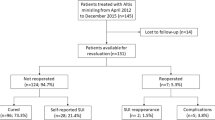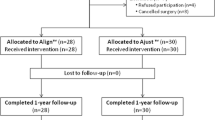Abstract
Introduction and Hypothesis
Single-incision slings (SIS) have emerged as a less invasive alternative to conventional slings for stress urinary incontinence (SUI) treatment. However, long-term efficacy and safety results remain uncertain owing to a lack of studies.
Material and methods
A retrospective review of 155 patients treated with Altis® for SUI between February 2012 and June 2017, held in 2022, as a continuation of a prospective study in which all patients (197) were reviewed for 2 years after surgery (1, 6, 12, and 24 months). Preoperative demographic data, comorbidities, and pressure-flow studies were also recorded. Continence status and satisfaction rates were assessed using the International Consultation on Incontinence Questionnaire–short form (ICIQ-SF) and the Patient Global Impression of Improvement (PGI-I) respectively. The assessment in the 2022 retrospective review was performed via a telephone survey.
Results
Mean follow-up time after surgery was 85.3 months (82.5–88.1). In 2022, complete continence was present in 75.4% of the patients. The presence of urinary urgency conditioned the ICIQ-SF score (10.9 vs 1.7 points, p < 0.01), with the ICIQ-SF = 0 in 84.5% of the patients with no associated urgency. Satisfaction assessed by the PGI-I was high, with 84.6% of the patients showing improvement. De novo urgency was present in 37,9% of the patients by 2022. Urinary tract infections were the most frequent complication (9.7%), with only 5 documented cases of mesh erosion.
Conclusions
Altis® SIS is a safe and effective device for SUI treatment, with satisfaction rates comparable with those of the conventional slings. Persistence or development of urinary urgency influences the results.



Similar content being viewed by others
References
Ulmsten U, Petros P. Intravaginal slingplasty (IVS): an ambulatory surgical procedure for treatment of female urinary incontinence. Scand J Urol Nephrol. 1995;29(1):75–82.
Petros PEP, Ulmsten UI. An integral theory of female urinary incontinence. Acta Obstet Gynecol Scand. 1990;69:7–31.
Delorme E. La bandelette trans-obturatrice: un procédé mini-invasif pour traiter l’incontinence urinaire d’effort de la femme. Prog Urol. 2001;11(6):1306–13.
Nambiar A, Cody JD, Jeffery ST, Aluko P. Single-incision sling operations for urinary incontinence in women. Cochrane Database Syst Rev. 2017;26(7):CD008709.
Carter E, Johnson EE, Still M, et al. Single-incision sling operations for urinary incontinence in women. Cochrane Database Syst Rev. 2023;10(10):CD008709.
Kocjancic E, Tu L, Erickson T, Gheiler E, Van DD. The safety and efficacy of a new adjustable single incision sling for female stress urinary incontinence. J Urol. 2014;192(5):1477–82.
Kocjancic E, Erickson T, Tu L-M, Gheiler E, Van Drie D. Two-year outcomes for the Altis ® adjustable single incision sling system for treatment of stress urinary incontinence. Neurourol Urodyn. 2017;36(6):1582–7.
Tieu AL, Hegde A, Castillo PA, Davila GW, Aguilar VC. Transobturator versus single incision slings: 1-year results of a randomized controlled trial. Int Urogynecol J. 2017;28(3):461–7.
Dogan O, Kaya AE, Pulatoglu C, Basbug A, Yassa M. A randomized comparison of a single-incision needleless (Contasure-needleless®) mini-sling versus an inside-out transobturator (Contasure-KIM®) mid-urethral sling in women with stress urinary incontinence: 24-month follow-up results. Int Urogynecol J. 2018;29(9):1387–95.
Abdel-Fattah M, Cooper D, Davidson T, et al. Single-incision mini-slings for stress urinary incontinence in women. N Engl J Med. 2022;386(13):1230–43.
Gromicho A, Días J, Araújo D, Rodrigues R, Kheir GB, Ferraz L. Long-term outcomes of Altis® single-incision sling procedure for stress urinary incontinence. Int Urogynecol J. 2022;33(3):717–22.
Natale F, Illiano E, Marchesi A, La PC, Costantini E. Transobturator tape: over 10 years follow-up. Urology. 2019;129:48–53.
Svenningsen R, Staff AC, Schiøtz HA. Long-term follow-up of the retropubic tension-free vaginal tape procedure. Int Urogynecol J. 2013;24(8):1271–8.
Nilsson CG, Palva K, Aarnio R, Morcos E, Falconer C. Seventeen years’ follow-up of the tension-free vaginal tape procedure for female stress urinary incontinence. Int Urogynecol J. 2013;24(8):1265–9.
Mira L, Cassio G, Zanettini L, et al. Mini-sling Ophira at 8 years follow-up: does it sustain results? Urol Int. 2019;102(3):326–30.
Jung SY, Fraser MO, Ozawa H, et al. Urethral afferent nerve activity affects the micturition reflex; implication for the relationship between stress incontinence and detrusor instability. J Urol. 1999;162(1):204–12.
Coyne KS, Sexton CC, Thompson CL, et al. The prevalence of lower urinary tract symptoms (LUTS) in the USA, the UK and Sweden: results from the Epidemiology of LUTS (EpiLUTS) study. BJU Int. 2009;104(3):352–60.
Funding
This study was not supported by any grants.
Author information
Authors and Affiliations
Contributions
R.G.L., H.G.G., C.G.E. contributed to the design and implementation of the research, L.M.Q.F. and A.D.P.F. to the analysis of the results and to the writing of the manuscript. C.G.E. conceived the original and supervised the project.
Corresponding author
Ethics declarations
Ethical compliance
All procedures performed in this study involving human participants were in accordance with ethical standards.
Conflicts of interest
The authors declare that they have no affiliations with or involvement in any organization or entity with any financial interest in the subject matter or materials discussed in this manuscript.
Additional information
Handling Editor: Rufus Cartwright
Editor in Chief: Maria A. Bortolini
Publisher's Note
Springer Nature remains neutral with regard to jurisdictional claims in published maps and institutional affiliations.
Supplementary information
Below is the link to the electronic supplementary material.
Rights and permissions
Springer Nature or its licensor (e.g. a society or other partner) holds exclusive rights to this article under a publishing agreement with the author(s) or other rightsholder(s); author self-archiving of the accepted manuscript version of this article is solely governed by the terms of such publishing agreement and applicable law.
About this article
Cite this article
Quintana Franco, L.M., González López, R., Garde García, H. et al. Long-Term Outcomes of the Altis® Single-Incision Sling: Up to 10 Years’ Follow-up. Int Urogynecol J (2024). https://doi.org/10.1007/s00192-024-05767-7
Received:
Accepted:
Published:
DOI: https://doi.org/10.1007/s00192-024-05767-7




